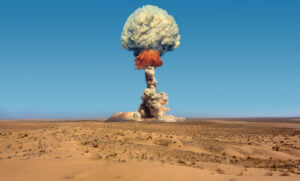
Imagine looking up at the sky and seeing a huge explosion that lights everything around you. This really happened during a time when countries tested nuclear bombs in the open air.
Let’s talk about what atmospheric nuclear testing is, why it happened, and what it means for us today.
What is Atmospheric Nuclear Testing?
Atmospheric nuclear testing means setting off nuclear bombs in the air. Unlike underground tests, these explosions are visible and spread radioactive particles into the atmosphere. These tests were common during the Cold War.
Between 1945 and 1980, over 500 atmospheric nuclear tests were done by countries like the United States, the Soviet Union, and France. They did these tests to show off their military strength and to understand how nuclear weapons worked.
However, these atmospheric nuclear tests also had bad effects that we still deal with today.
The History of Atmospheric Nuclear Testing
Atmospheric nuclear testing started in 1945 with the Trinity Test in New Mexico. This test was the beginning of the nuclear age.
A few weeks later, atomic bombs were dropped on Hiroshima and Nagasaki, ending World War II. After the war, the U.S. continued atmospheric nuclear testing in places like Bikini Atoll and Nevada.
The Soviet Union started testing in 1949. This led to an arms race, where countries competed to have the most powerful weapons.
Other countries like the United Kingdom, France, and China also started atmospheric nuclear testing. These tests went on until the Partial Test Ban Treaty of 1963, which banned all tests except those done underground.
Why Were These Tests Conducted?
Countries did the atmospheric nuclear testing for a few reasons. First, they needed to understand how nuclear weapons worked. These atmospheric nuclear tests helped scientists and military leaders make better weapons. Second, nations wanted to show off their military power, especially during the Cold War.
Finally, they wanted to study the effects of nuclear explosions. Scientists wanted to know how the blasts would impact buildings, landscapes, and living things.
These atmospheric nuclear tests gave them valuable information but caused a lot of damage to the environment and public health.
The Science of Atmospheric Nuclear Explosions
When a nuclear bomb goes off in the air, several powerful things happen almost immediately. Let’s start with the basics: a nuclear bomb releases a gigantic amount of energy stored in atoms. When these atoms are split apart or joined together, they release a massive burst of energy, causing an explosion.
The Fireball and Heat
As soon as the bomb explodes, it creates a huge fireball that is super hot—hotter than the surface of the sun. This fireball is a glowing ball of gas, and the heat it produces can cause bad burns even miles away.
The intense heat also makes the nearby air expand quickly and glow, which is why a nuclear explosion is so bright.
The Shockwave
Along with the fireball, the explosion creates a powerful shockwave. This shockwave is like a super-strong wave of pressure that travels outwards from the explosion very fast.
It’s similar to a powerful blast of wind but much stronger, and it can crush buildings and cause a lot of damage.
Radiation
Another dangerous effect of atmospheric nuclear testing is the release of radiation. Radiation is made up of tiny particles and energy that shoot out from the explosion.
These particles can be very harmful to living things. Being exposed to high levels of radiation right away can cause serious health problems like radiation sickness, which has symptoms such as vomiting, bleeding, and hair loss.
Fallout
After the explosion, radioactive particles called fallout start to fall back down to Earth. These particles come from the bomb and from the materials that were vaporized by the explosion.
Fallout can spread over large areas, carried by the wind. It contaminates the soil, water, and air, making these environments unsafe for a long time.
Long-Term Effects
The effects of atmospheric nuclear testing don’t stop with the initial blast and radiation. The radioactive fallout can cause long-term health problems like cancer and genetic damage, which can affect future generations.
The environment can take many years to recover from such contamination, affecting plants, animals, and entire ecosystems.
Atmospheric Nuclear Test Compensation
In the United States, a law called the Radiation Exposure Compensation Act (RECA) was passed in 1990. This law helps people who got sick because of nuclear testing.
If you or a family member have been diagnosed with a covered internal cancer or Leukemia within the last 70 years and have lived in Arizona, Colorado, Idaho, Montana, Nevada, New Mexico, or Utah, you may be eligible for compensation. The diagnosis must have occurred after residing in any of these states for at least one year between January 21, 1951 and October 31, 1958, or the entire month of July 1962.
At Downwinders®, we have been working to help individuals who qualify for compensation. Our highly experienced providers not only help check your eligibility for compensation but also provide guidance and support throughout the process of claiming compensation.
If you have previously filed and been paid under the current legislation, there may be additional compensation available for you.
For further information, contact us using our registration form. We look forward to serving you!
